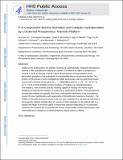| dc.contributor.author | Lin, Yi-Chun | |
| dc.contributor.author | Hatzakis, Emmanuel | |
| dc.contributor.author | McCarthy, Sean M. | |
| dc.contributor.author | Reichl, Kyle D. | |
| dc.contributor.author | Lai, Ting-Yi | |
| dc.contributor.author | Yennawar, Hemant P. | |
| dc.contributor.author | Radosevich, Alexander T. | |
| dc.date.accessioned | 2018-04-20T18:10:40Z | |
| dc.date.available | 2018-04-20T18:10:40Z | |
| dc.date.issued | 2017-04 | |
| dc.date.submitted | 2017-03 | |
| dc.identifier.issn | 0002-7863 | |
| dc.identifier.issn | 1520-5126 | |
| dc.identifier.uri | http://hdl.handle.net/1721.1/114818 | |
| dc.description.abstract | Studies of the stoichiometric and catalytic reactivity of a geometrically constrained phosphorous triamide 1 with pinacolborane (HBpin) are reported. The addition of HBpin to phosphorous triamide 1 results in cleavage of the B-H bond of pinacolborane through addition across the electrophilic phosphorus and nucleophilic N-methylanilide sites in a cooperative fashion. The kinetics of this process of were investigated by NMR spectroscopy, with the determined overall second-order empirical rate law given by ν = -k[1][HBpin] , where k = 4.76 × 10 -5 M -1 s -1 at 25 °C. The B-H bond activation process produces P-hydrido-1,3,2-diazaphospholene intermediate 2, which exhibits hydridic reactivity capable of reacting with imines to give phosphorous triamide intermediates, as confirmed by independent synthesis. These phosphorous triamide intermediates are typically short lived, evolving with elimination of the N-borylamine product of imine hydroboration with regeneration of the deformed phosphorous triamide 1. The kinetics of this latter process are shown to be first-order, indicative of a unimolecular mechanism. Consequently, catalytic hydroboration of a variety of imine substrates can be realized with 1 as the catalyst and HBpin as the terminal reagent. A mechanistic proposal implicating a P-N cooperative mechanism for catalysis that incorporates the various independently verified stoichiometric steps is presented, and a comparison to related phosphorus-based systems is offered. | en_US |
| dc.description.sponsorship | National Science Foundation (U.S.) (Grant CHE-1724505) | en_US |
| dc.description.sponsorship | National Institutes of Health (U.S.) (Grant GM114547) | en_US |
| dc.publisher | American Chemical Society (ACS) | en_US |
| dc.relation.isversionof | http://dx.doi.org/10.1021/jacs.7b02512 | en_US |
| dc.rights | Article is made available in accordance with the publisher's policy and may be subject to US copyright law. Please refer to the publisher's site for terms of use. | en_US |
| dc.source | PMC | en_US |
| dc.title | P–N Cooperative Borane Activation and Catalytic Hydroboration by a Distorted Phosphorous Triamide Platform | en_US |
| dc.type | Article | en_US |
| dc.identifier.citation | Lin, Yi-Chun et al. “P–N Cooperative Borane Activation and Catalytic Hydroboration by a Distorted Phosphorous Triamide Platform.” Journal of the American Chemical Society 139, 16 (April 2017): 6008–6016 © 2017 American Chemical Society | en_US |
| dc.contributor.department | Massachusetts Institute of Technology. Department of Chemistry | en_US |
| dc.contributor.mitauthor | Lin, Yi-Chun | |
| dc.contributor.mitauthor | Radosevich, Alexander T. | |
| dc.relation.journal | Journal of the American Chemical Society | en_US |
| dc.eprint.version | Author's final manuscript | en_US |
| dc.type.uri | http://purl.org/eprint/type/JournalArticle | en_US |
| eprint.status | http://purl.org/eprint/status/PeerReviewed | en_US |
| dc.date.updated | 2018-04-19T13:58:55Z | |
| dspace.orderedauthors | Lin, Yi-Chun; Hatzakis, Emmanuel; McCarthy, Sean M.; Reichl, Kyle D.; Lai, Ting-Yi; Yennawar, Hemant P.; Radosevich, Alexander T. | en_US |
| dspace.embargo.terms | N | en_US |
| mit.license | PUBLISHER_POLICY | en_US |
